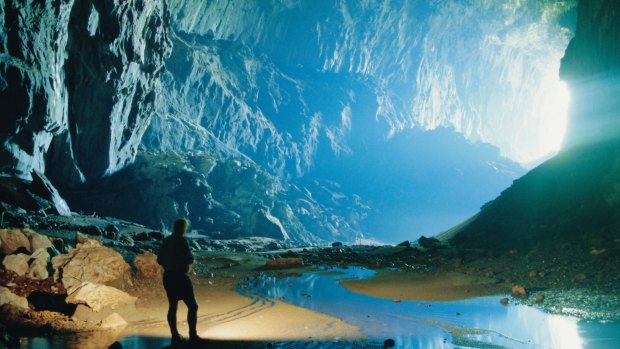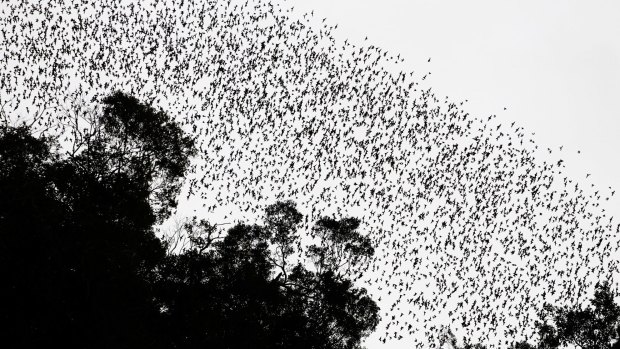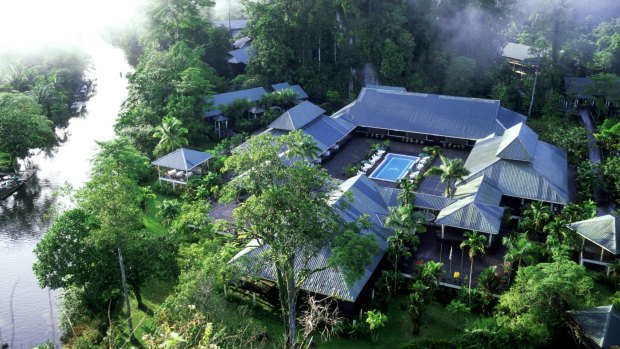This was published 7 years ago
Things to do in Gunung Mulu National Park, Sarawak, Malaysian Borneo: Watching the daily bat exodus
It's been more than an hour and I've been waiting patiently in a clearing deep in the dense jungle of Gunung Mulu National Park in Sarawak, my eyes fixed on the distance as I await one of the world's great, if not more perverse, spectacles of nature. It's the daily exodus of almost two million wrinkle-lipped bats from an entrance of Deer Cave as they head out for the night to gorge on insects.
One of nature's greatest feeding frenzies, this event explains why malaria and other mosquito-borne diseases are uncommon on this part of the island. In an illustration of nature's delicate balance, without the bats, insect plagues, illness and epidemics would ensue, and without the insects the bats would doubtless starve.
But, as time ticks away, it looks like the assembled tourists, myself included, will need to return to this spot tomorrow afternoon to witness this supposedly extraordinary sight which can occur any time between 4.30pm and 6pm and occasionally, due to inclement weather or other unknown reasons, not at all. In the age of instant gratification such inconvenience, even at the contrary hands of nature, can be hard to accept.

Deer Cave, which is home to a colony of wrinkled-lipped bats when they're not out feeding.
There has been a drop of rain this afternoon that does appear to have deterred the bats' appearance and I can't help thinking, as I gather my day-pack to begin the walk back to the national park's ranger headquarters, that this is a classic case of see you tomorrow, "same bat-time, same bat-cave" (or something like that).
Then, as the last of the rain clears and patches of late afternoon blue sky reveals, someone in the small crowd in the clearing, named the "bat observatory", excitedly detects some activity. This time it's not the circling swiflets we'd earlier mistaken for bats.
A long tar-black spiralling stream pours from the cave entrance, the whooshing sound emitted from the thousands of flapping wings akin to that of a distant passenger jet, with a bat estimated to consume five grams of insects a night.

Millions of wrinkle lipped free tailed bats leave Deer Cave in Gunung Mulu National Park at dusk, Mulu, Malaysia. Credit: Getty Images
Then, just as I'm congratulating myself for having had the patience to not have left the bat observatory when I planned, thousands more bats pour from the cave, and then more and more of the creatures though, against the backdrop of the jungle it can be difficult to discern them, even through binoculars, until they're fully in the sky.
It's the most mesmerising of spectacles with certain groups of wrinkle-lipped bats – a most unlovely-looking creature up close, judging from photographs – favouring not a spiral formation but an odd donut-like one. Fortunately for the bats, on this afternoon there's no sign of the hawks, at least not while I'm present, which prey on members of these airborne packs as they emerge, no doubt picking off the weakest members of each group.
Borneo, after Greenland and Papua New Guinea, is the world's third largest island (Australia is classified as an island continent). Sarawak is one of two Malaysian states on Borneo, the other being Sabah, and the contrast couldn't be greater. Even without the extraordinary exodus of the bats, the UNESCO World Heritage-listed Gunung Mulu National Park would be more than worthy of the trip from Kuala Lumpur as the attractions are as numerous as they are diverse.

Mulu Marriott Resort and Spa.
Despite reeking of heroic amounts of bat guano, one of the part's greatest sights is Deer Cave, home to the colony of wrinkled-lipped bats when they're not out feeding. Deer Cave includes the longest cave passage on the planet, weaving its way for no less than two kilometres from one end of another. Passing through a 460-metre limestone mountain, at the cave's highest and widest point (120 metres and 175 metres respectively) standing on the cave floor can feel like you're in the middle some stark and strange enclosed valley.
In fact, it's so immense that it's said London's St Paul's Cathedral could be contained five times over. To visit Deer Cave, which can be done only in the company of an official park ranger, it's necessary to walk three kilometres through dense rainforest along a timber-boarded walkway, encountering along the way fluttering specimens of the magnificent black and green Rajah Brooke's birdwing butterfly.
It was named by the naturalist Alfred Russel Wallace, a contemporary of Charles Darwin, in 1855, in honour of James Brooke, the famed English-born "White Rajah" of Sarawak. Even today, long after the end of the White Rajah rule, Mulu remains one of the more remote parts of south-east Asia. There is no road access with the only alternative to air transport – with flights to and from Kuching, the capital of Sarawak – being a 10-hour or so journey by boat along the river that runs down to Miri, a nondescript coastal city.
Mulu's next unmissable experience for visitors who don't suffer from vertigo is the Canopy Skywalk, at 480 metres long and up to 30 metres high, the longest tree-based walkway of its kind in the world. Unlike other such forest canopy walks, the Canopy Skywalk's narrow rope suspension bridges are supported not by concrete pillars or poles at either end but by the thick trunks of actual towering trees with platforms built around their trunks for pausing between the walks.
The walk is not for the faint-hearted but it's a lot less daunting than the hike to the Pinnacles, one of the world's most spectacular limestone formations. Situated at a height of 1200 metres, the Pinnacles resemble upturned knives jammed into the earth. Fitter, more adventures and possibly more fool-hardy visitors to Mulu than me tackle the hike, described, rather off-puttingly, as a "very physically challenging, high-risk, adventure activity", that can only be undertaken as a part of park guide-led three-day, two-night tour.
On my last afternoon in Mulu, after an all-too-brief two-day visit, despite threatening skies I'm persuaded not to cancel my sunset cruise on the river, swathed in jungle for the most part, that passes through the national park and beside pockets of villages.
Of course, out on the river, as the boat turns around for the return journey, those skies become roughly the colour of the swarms of Deer Cave bats and soon enough the heavens open with the force of a sudden dam burst. As I struggle in the boat to don a poncho – Asian-sized, wouldn't you know it? – in the pounding rain I recall those wrinkled-lipped bats, no doubt dry and snug in their cave, having wisely delayed their evening dinner date until the weather clears.
When we arrive at the jetty at my accommodation, the Mulu Marriott Resort & Spa, I immediately disembark from the boat and race up the stairs to the shelter of reception. I fail to realise that I'm still sporting my life-jacket under my ridiculously ill-fitting poncho.
One of the poor boatmen has to run up the stairs in the deluge to retrieve it for the next passenger, though even in this downpour he can still see the funny side as I hand it back to him. But, as I stand there dripping and in an ever-expanding puddle, I conclude that copping one hell of a tropical drenching is the smallest price to pay for visiting this extraordinary, little-known corner south-east Asia.
FIVE MORE THINGS TO DO IN MULU
HEADHUNTERS TRAIL
A relatively easy, four- to five-hour walk, this trail traces part of an ancient route taken by native headhunting parties. It passes through rainforests, traverses jungle and crosses suspension bridges above rivers.
MULU SUMMIT WALK
A hike covering 24 kilometres and encompassing a minimum four days and three nights, this trail climbs to nearly 2400 metres. Along the way walkers pass through montane forests and stunted shrub land at the summit.
CLEARWATER CAVE
At 107 kilometres in length, Clearwater is Asia's longest cave and is reached via a concrete 200-step staircase. Many expeditions were required to survey the cave system, with much of it remaining unexplored.
CAVE OF THE WINDS
A river once flowed through this cave, which is reached on the same 20- to 40-minute longboat journey from park headquarters as Clearwater Cave. The now dry riverbed passage of Cave of the Winds features the spectacular Kings Chamber.
TRIP NOTES
MORE INFORMATION
GETTING THERE
Malaysia Airlines operates regular flights to Mulu from Kuching and Miri in Sarawak, and Kota Kinabalu in Sabah. There are regular direct flights to Kuching and Miri from Kuala Lumpur. Note that flight timetables to and from Mulu are subject to disruptive last-minute changes which can affect connections onto Kuala Lumpur. See malaysiaairlines.com
VISITING THERE
It's worth hiring a guide during a visit to Gunung Mulu National Park, especially if you're visiting for a short time and want to squeeze in as a many sights and experiences as possible. However, visitors to the caves must be accompanied by a park ranger. When you're there, be sure to pick up a copy of an informative book, A Guide to Gunung Mulu National Park: A World Heritage Site in Sarawak, Malaysian Borneo by Hans P. Hazebroek, Abang Kashim bin Abang Morshidi.
STAYING THERE
The best accommodation at Mulu is the excellent five-star Mulu Marriott Resort & Spa. Doubles start from MYR490 ($158). The resort is quite dispersed so try for a room closer to the reception, pool and the public areas. See marriott.com.au
Anthony Dennis travelled as a guest of Tourism Malaysia, Sarawak Tourism and Mulu Marriott Resort & Spa.
Sign up for the Traveller Deals newsletter
Get exclusive travel deals delivered straight to your inbox. Sign up now.